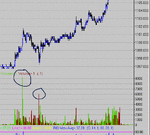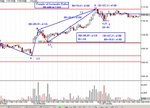Ok. Just 'cos you asked so nicely....The diminishing volumes on the 1 min chart , as prices make lower lows, shows a lack of interest or ability to push the price any lower..... But this goes against your theory ( which I agree with and understand) that prices rise on diminishing volumes.
I have to agree, also, that the 1 min chart ( and in particular the volume) is just too noisy. You can, too, on odd ocaisions, see blow of bottoms and tops, indicating a reversal. I just can't quite see the path through to the dark side.... 🙁
Blow off top on ES 1 min 29/12/03 chart....strangely enough, not a bad BOB as well.
I have to agree, also, that the 1 min chart ( and in particular the volume) is just too noisy. You can, too, on odd ocaisions, see blow of bottoms and tops, indicating a reversal. I just can't quite see the path through to the dark side.... 🙁
Blow off top on ES 1 min 29/12/03 chart....strangely enough, not a bad BOB as well.


